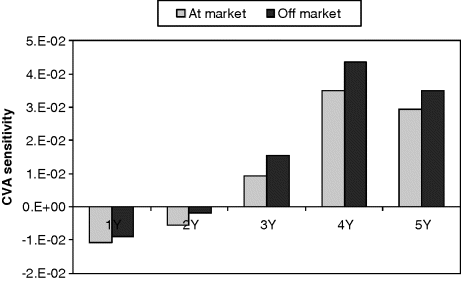16.5 Cross-dependency
We now consider cross-dependency between exposure and credit as characterised by the third term in equation (16.1). This is often known as cross-gamma and can significantly complicate the hedging process and cause large losses even for seemingly well-hedged positions.
16.5.1 Re-hedging Costs
Let us first consider the case where exposure and credit are independent (no wrong- or right-way risk). Figure 16.13 shows how the sensitivity of CVA changes as interest rates move up by 50 bps. In this payer swap (receiving the floating rate) example, the swap becomes more in-the-money and there is a reasonable change in sensitivities. A move in interest rates means that the credit hedge will have to be adjusted significantly, even if CDS premiums have not moved. Similar effects can be seen across other variables, for example, a move in volatility causes a similar change in credit hedges. Correspondingly, a move in credit spreads changes interest rate sensitivities.
Figure 16.13 Sensitivity of the interest rate swap CVA to changes in CDS premiums of various maturities for an at-market and off-market swap (interest rates moved up by 50 bps). The CDS premiums are assumed flat at 500 bps.

16.5.2 Cross-gamma
Cross-gamma is the term used to describe a dependency between two underlying variables. If there is correlation between variables then the cross-gamma term(s) will be ...
Get Counterparty Credit Risk and Credit Value Adjustment: A Continuing Challenge for Global Financial Markets, 2nd Edition now with the O’Reilly learning platform.
O’Reilly members experience books, live events, courses curated by job role, and more from O’Reilly and nearly 200 top publishers.

